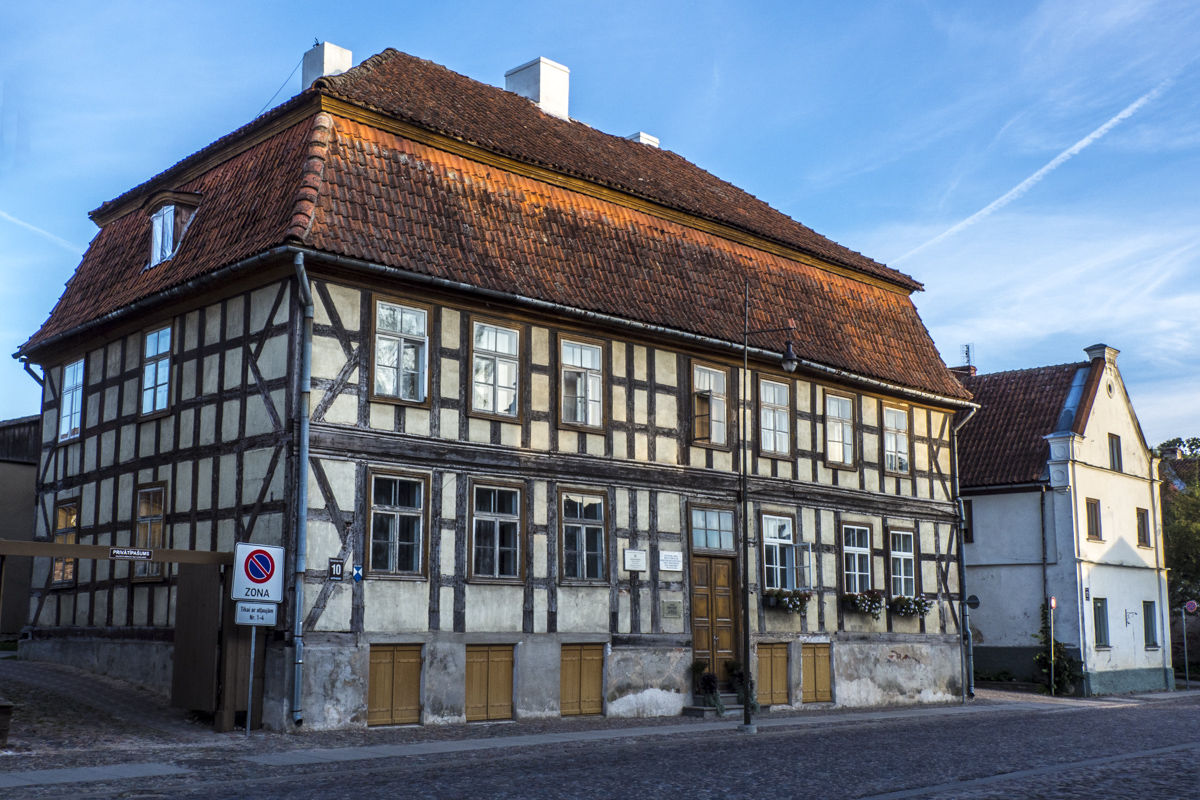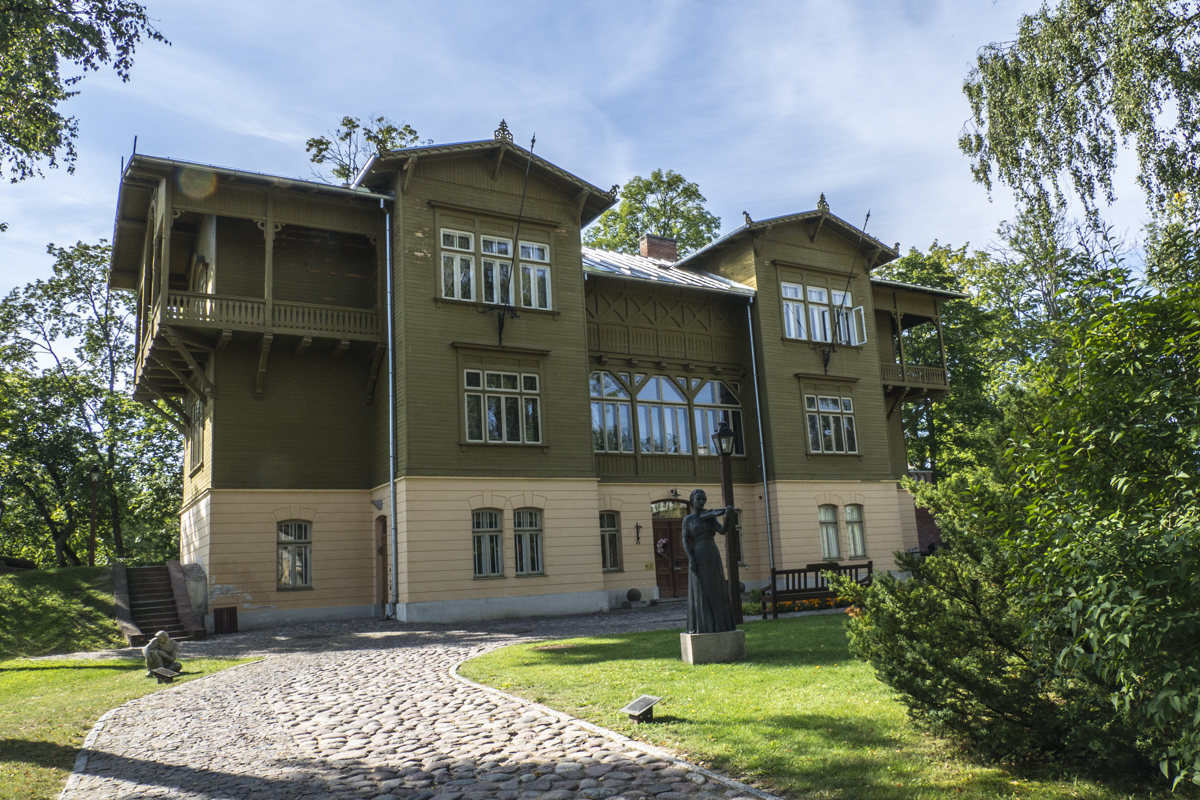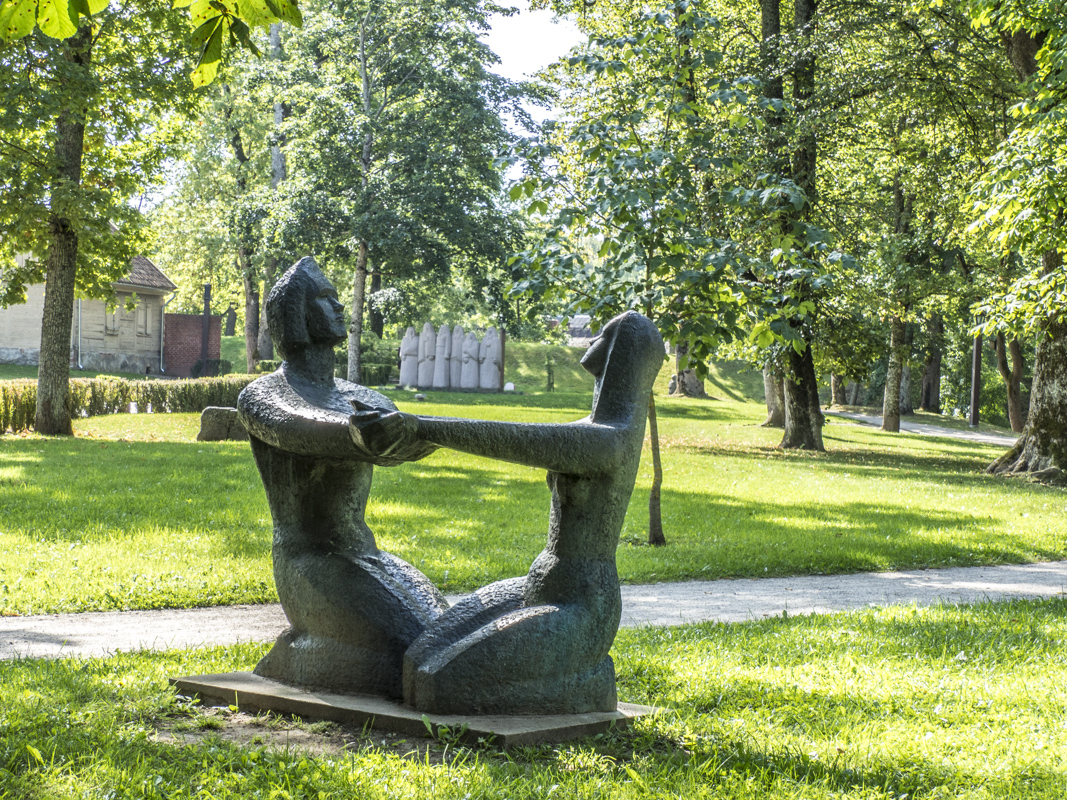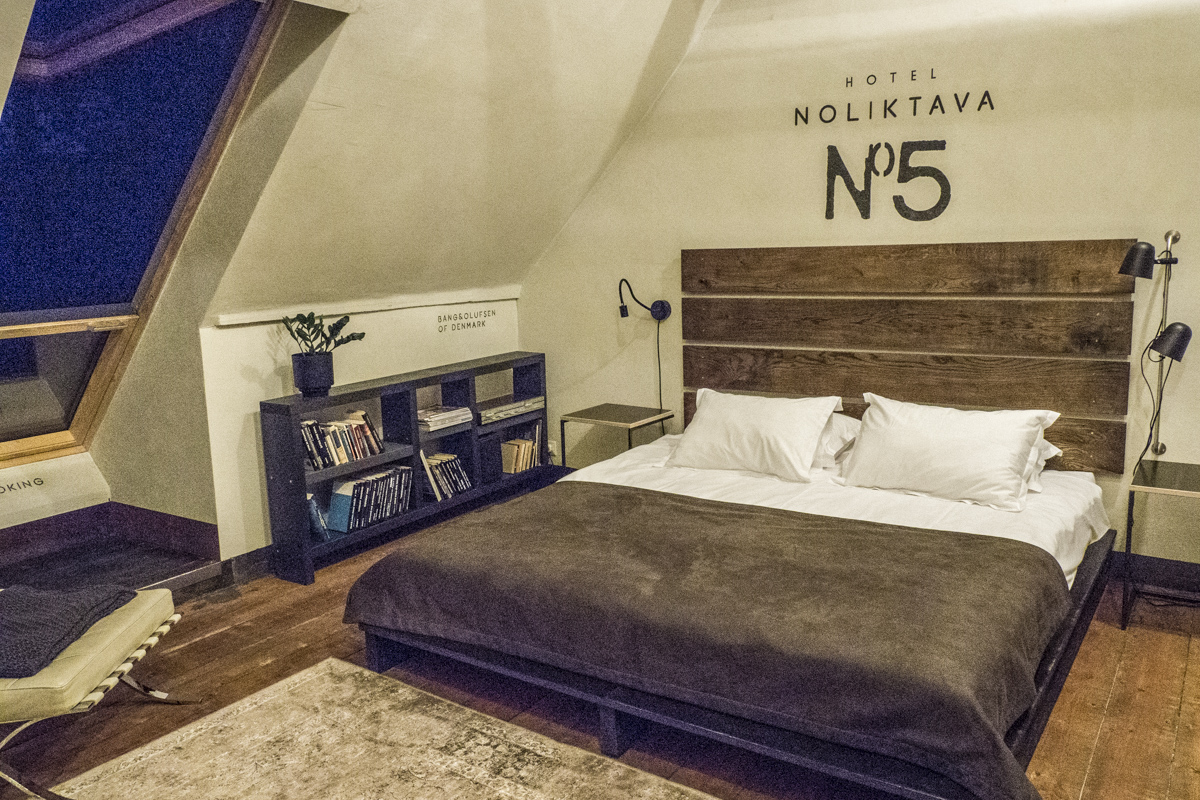
Originally a German Dukedom and later a Soviet state Kuldīga is now blossoming as it builds its own unique identity through the sensitive restoration of its beautiful old buildings.
This diverse heritage is reflected in three beautiful churches of three different denominations, Lutheran, Catholic and Russian Orthodox. Walk with me through the narrow streets of the old town down to the banks of the Venta River and the Ventas Rumba, the widest waterfall in Europe. On my way I crossed several bridges that span the Alekšupīte River. This small river is part of the fabric of the old town.

Russian Orthodox Church in Kuldīga, Latvia
The Alekšupīte River of Kuldīga in Latvia
Two rivers run through the town of Kuldīga a small town in the Kurzeme region of Latvia. The Venta River flows by the old town whereas the smaller Alekšupīte River runs through its centre, lapping at the walls of the buildings it flows past.

Alekšupīte River in Kuldīga in Latvia
This Alekšupīte River is only eight kilometres long and on its course through the town it is crossed by nine bridges. When people get married here it is considered lucky to cross seven of these bridges. An annual race takes place every July when the contestants run along the river bed.

Bridge over the Alekšupīte River in Kuldīga in Latvia
Before the Alekšupīte River joins the Venta River it rushes over the Alekšupīte Waterfall. During the seventeenth century the natural waterfall was restored and this artificial waterfall became the source of power to operate the first paper mill in the region of Kurzeme. This mill was housed in the ancient Castle Mill built in the thirteenth century. Today this ancient mill stands empty.

Alekšupīte Waterfall in Kuldīga in Latvia
The Town Hall Square of Kuldīga in Latvia
Prominent at the far end of the main square (Rātslaukums) is the new town hall. An attractive yellow building in the Italian Renaissance style it was built in 1860. Its balcony is a popular venue for wedding ceremonies. Overlooking the square is the impressive Catholic church of the Holy Trinity. The church was completed in 1642 when there were no Catholics living here. However, a Catholic Church was a pre-requisite for contenders for the dukedom of the former territory of the Cours. It has the most interesting interior of all the Catholic churches in the region. The entrance is through the monastery of the Dominican sisters. A fountain in the centre of the square was created in the shape of a boat. This is the same shape as the meat sellers’ shop that once stood here. Those were the days when the square was the market place. The oldest building in this square is the Old Town Hall.

Town Hall Square in Kuldīga in Latvia
The Old Town Hall of Kuldīga in Latvia
The Old Town Hall was built during the seventeenth century. Its cellar was the first prison in Kuldīga. Today, following extensive renovation in 2915, it houses the Tourist Information Centre. The restoration of this building was the start of a project to sensitively restore all the old wooden buildings in Kuldīga. Everyone is involved and general meetings are sometimes held to discuss issues that arise. One of the issues that was discussed was the colour the restored building should be painted. It was agreed it should be painted black.

The Old Town Hall in Kuldīga in Latvia
Inside the centre visitors will find a wealth of information about the town, its attractions and forthcoming events. There is also a function room that has been restored to its original form and is now used for exhibitions. There is also a small handicrafts centre with demonstrations of the local crafts of weaving and lace-making.

Workshop in the Old Town Hall in Kuldīga in Latvia
Visitors may wonder who it is sitting outside the old town hall waiting for someone to join him in a cup of coffee. It is Ēvalds Valters probably Latvia’s most popular actor. He starred in a number of films by the Riga Film Studio. At one time he was the oldest working actor in the world. He received the honorary title of People’s Actor.

Actor Ēvalds Valters Outside the Old Town Hall in Kuldīga in Latvia
The Restoration Project in Kuldīga in Latvia
The restoration project for the citizens of Kuldīga old town was started in 2000. In 2009 it was formalised with the introduction of a programme known as the Regular Maintenance of the Windows . Its aim was to encourage the active participation of local people in the preservation of the old town. Rules of the restoration project forbid the use of plastic materials on the exteriors of the buildings. The municipality covers the cost of materials and advice is available from restoration specialists. In 2018 the Kuldīga Restoration Centre opened. This project is proving to be very successful with families working together to restore their properties. There are many indications that restoration is an on-going project particularly along Baznicas iela, one of the oldest streets in the town. New doors, new shutters and new windows are a regular feature of the old buildings that line this street.

New Door in a Property on Baznicas iela in Kuldīga in Latvia
Baznicas iela in Kuldīga in Latvia
The Town Hall Square is at the top of Baznicas iela or Church Street and the oldest church in Kuldīga, Saint Catherine’s https://www.celotajs.lv/en/e/svkatrinasluteranubaznica (Sv Katerina) is at the other end, hence the name. On my way to the church I passed the Duke’s Pharmacy built in 1662. It is one of the few buildings that was constructed using the German filled timber framing technique. It was the pharmacy for a long time and was called the Duke’s pharmacy because it had to obtain a licence to operate from the Duke.

The Duke’s Pharmacy in Kuldīga in Latvia
The Evangelical Lutheran Church of Sv Katarina https://www.celotajs.lv/en/e/svkatrinasluteranubaznica is the oldest church in Kuldīga and it is also one of the oldest buildings in the town. It was built in 1665 replacing a wooden church that was built here in 1252. It has undergone several renovations since it was built. Sv Katarina, a martyr, is also the patron saint of Kuldīga. This church houses a large collection of bibles. From the top of the steeple visitors get a good, panoramic view of the old town below.

The Steeple of the Church of SV Katarina in Kuldīga in Latvia
Venta River in Kuldīga in Latvia
Baznicas iela goes all the way through the old town and emerges on the bank of the Venta River. And what a glorious sight it is. Spanning this wide river is the old brick bridge 164 metres long. Built in 1874 it is one of the longest bridges in Europe. The naked run is held across this bridge every midsummer when naked people run across the bridge and plunge into the river.

The Old Arch Bridge Across the Venta River in Kuldīga in Latvia
Downstream the waters of the Venta tumble over the Venta Waterfall (Ventas Rumba). Its height is not impressive but its width, 110 metres, makes it widest in Europe. In autumn and spring visitors can enjoy the sight of the flying fish of Kuldīga. As huge shoals of salmon make their way upstream to spawn they try to jump over the waterfall. In days gone by baskets were placed along the rapids to catch them but his activity is now illegal.

Venta Waterfall on the Venta River in Kuldīga, Latvia
Museums in Kuldīga in Latvia
The Kuldīga District Museum (Kuldīgas Novada Muzejs) on the banks of the Venta River close to the waterfalls is rumoured to occupy the Russian Pavilion built for the Paris exhibition in 1900. The building underwent extension renovation before the museum opened in 2014. It offers various exhibitions including one narrating the history of the town. One floor has been laid out as the apartment of a rich family living in Kuldīga in the early twentieth century.

Kuldīgas Novada Muzejs in Kuldīga in Latvia
This museum is situated in a beautiful area of the town surrounded by the City Gardens (spilsetas darzs). These gardens were created on the site of the former Livonian Order Castle https://www.hanse.org/en/hanseatic-cities/kuldiga/. Just a few grassy humps remain as witness to its existence. The collection of sculptures on display in the gardens are the work of Līvija Razevska.

The City Gardens in Kuldīga in Latvia
A completely different approach to the history of Kuldīga can be found at the Living Museum in the centre of the old town. Here visitors can listen to the whispers of city walls, the moans of the cobblestones and songs of the weathervanes. Whenever I walked past this building I could hear voices or music – eerie.

The Living Museum in Kuldīga, Latvia
Where to Stay in Kuldīga in Latvia
I stayed at the Noliktava No 5 close to the Town Hall Square so it was very convenient for exploring the town. I had a lovely en suite attic room with a large skylight that opened out to form a small balcony.

Bedroom at Noliktava No 5 Kuldīga, Latvia
My meals were taken at the Goldingen Room on Town Hall Square. This restaurant has a nice atmosphere and friendly staff. I really enjoyed my evening meal there. The breakfast buffet was excellent. Well-presented and very varied.

Goldingen Room in Kuldīga in Latvia
Getting to Kuldīga in Latvia
Air Baltic operates direct flights to Riga. There is public transport available and at very reasonable prices but to benefit from the interesting and varied attractions in and around Kuldīga the best option is to hire a car.
It is time to leave Kuldīga and head for my next destination, Pāvilosta. Should I try the teleport at the end of Liepaja Street in Kuldīga by the flower-market? It symbolizes the passage from Kuldīga’s old town to the newer part of town. The front side, made of aluminium, represents the twenty-first century. The back, made of rusty iron, represents the seventeenth century. The figure passing through it is Duke Jacob Kettler, the town’s most influential ruler, coming back to Kuldīga from the past.

The Teleport in Kuldīga in Latvia
Available on GPSmyCity.com
This article is now featured on GPSmyCity. To download this article for offline reading or travel directions to the attractions highlighted in this article, go to Walking Tours in Kuldiga on GPSmyCity
This article is based on the personal experience of Valery, an ExperiencedTraveller..